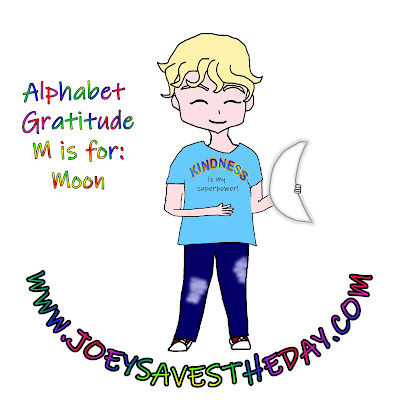Last week, we focused on expressing gratitude for items and experiences that begin with the letter L. Today, we invite you to share something you are thankful for that starts with the letter M. Your contributions can help foster a spirit of appreciation and reflection.
I'm grateful for the Moon. What are you grateful for that begins with the letter M?
🌕 More Than Just a Glow: Fun Facts About the Magical Moon
It lights up the night, inspires howling wolves and dreamy poems, and even tugs at the ocean. But the Moon isn’t just a glowing dot in the sky; it’s a powerful, puzzling, and playful companion to Earth. Ready to orbit some awesome Moon facts?
🌍 1. The Moon Is Earth’s Only Natural Satellite
That means it orbits Earth, always staying nearby like a loyal cosmic buddy. It’s about 238,855 miles away, which would take a car over 5 months to reach if you drove nonstop!
🌀 2. The Moon Controls Tides
Ever notice how the ocean comes and goes? That’s the Moon’s gravitational pull in action. It gently tugs on Earth’s water, creating high and low tides all around the globe.
🧁 3. The Moon Is Smaller Than You Think
It’s about one-fourth the size of Earth, which makes it smaller than some planets’ moons, but it still plays a big role in Earth’s stability.
🌓 4. The Moon Has Phases
New Moon, Full Moon, Crescent, Half, these are Moon phases, caused by the Moon’s position relative to the Sun and Earth. So yes, it’s not changing shape, it’s just changing outfits.
👣 5. Humans Have Walked on the Moon
In 1969, astronaut Neil Armstrong became the first person to walk on the Moon. The famous quote? “That's one small step for man, one giant leap for mankind.” Moon boots and history made!
🎖️ 6. Moon Trees Honor Veterans
Fun twist: NASA took tree seeds to the Moon during the Apollo missions. When they returned, the seeds were planted across the U.S. and grew into “Moon Trees”, many of which were dedicated to honoring veterans and communities. They’re living monuments of space and service!
🌑 7. The Moon Has No Light of Its Own
It only reflects the Sun’s light, kind of like a giant mirror in the sky. So when you see a bright full Moon, you’re seeing sunlight bouncing back from its dusty surface.
🌌 8. The Moon Has Mountains and Valleys
It’s not smooth, it’s bumpy! The Moon has craters, mountains, and even lava plains. In fact, the biggest crater, South Pole–Aitken, is over 1,500 miles wide!
🌕 Bonus Cosmic Crumbs!
- The Moon’s gravity causes Earth’s rotation to slow down slightly.
- There’s no atmosphere, so you can’t hear sounds or feel wind up there.
- Moon dust smells like burnt gunpowder (according to astronauts!).
- A full Moon can make some animals more active; nature’s nightlight effect.
There are many things to be thankful for! Expressing gratitude is beneficial for your well-being. It makes others happy as well as yourself. So, always remember to be grateful!
Get ready for an exhilarating week as we plunge into a vibrant celebration of everything that starts with the letter N! Let’s come together to express our gratitude for an array of delightful treasures, from cozy comforts to captivating curiosities. It’s time to fully embrace and revel in the fantastic wonders that this charming letter brings! Let’s make it a week to remember!
Get your worksheet here:
🌕 M Is for Moon: “My Thankful Moon Phase Mobile”
Let kids explore the moon’s phases while creating a dreamy mobile that reflects things they’re grateful for during different times of the month!
🎨 What You’ll Need:
- Black, white, and gray paper or cardstock
- String or yarn
- Glue, scissors, hole punch
- Crayons or markers
- Printable moon phase guide (optional)
🌗 Instructions:
Create Moon Phase Cutouts:
Cut out paper moons in different phases: new moon, crescent, half, gibbous, and full.Add Gratitude Messages:
On each moon, kids write or draw something they’re thankful for during different moods or seasons:- 🌑 New Moon: “I’m thankful for fresh starts.”
- 🌓 First Quarter: “I’m thankful for growing confidence.”
- 🌕 Full Moon: “I’m thankful for bright celebrations!”
Assemble the Mobile:
Punch a hole in each moon and string them vertically or in a spiral. Attach to a stick or hanger to display.Title It Creatively:
Try names like:- “Gratitude Through the Phases”
- “My Moonlight Thank You Mobile”
🌟 Bonus Bits:
- The moon affects ocean tides and bedtime stories, too!
- Astronauts from Apollo missions left gratitude messages and mementos on the moon’s surface.
- You can step outside and track the moon’s phase each night, just like a kindness calendar.
Books about the Moon:
1. I Am the Moon: by Rebecca McDonald
2. Moon! Earth's Best Friend by Stacy McAnulty
3. So That's How the Moon Changes Shape! by Allan Fowler
4. What is the Moon? by Katie Daynes
Parents ensure that books are suitable for children before reading them aloud.








No comments:
Post a Comment